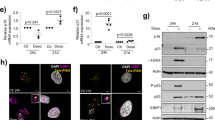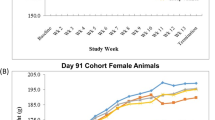Abstract
Neointimal hyperplasia resulting from vascular smooth muscle cell (SMC) proliferation and luminal migration is the major cause of autologous vein graft failure following vascular coronary or peripheral bypass surgery. Strategies to attenuate SMC proliferation by the delivery of oligonucleotides or genes controlling cell division rely on the use of high concentrations of vectors, and require pre-emptive disruption of the endothelial cell layer. We report a genetically engineered herpes simplex virus (HSV-1) mutant that, in an in vivo rabbit model system, infects all vascular layers without prior injury to the endothelium; expresses a reporter gene driven by a viral promoter with high efficiency for at least 4 weeks; exhibits no systemic toxicity; can be eliminated at will by administration of the antiviral drug acyclovir; and significantly reduces SMC proliferation and restenosis in vein grafts in immunocompetent hosts.
This is a preview of subscription content, access via your institution
Access options
Subscribe to this journal
Receive 12 print issues and online access
$259.00 per year
only $21.58 per issue
Buy this article
- Purchase on Springer Link
- Instant access to full article PDF
Prices may be subject to local taxes which are calculated during checkout





Similar content being viewed by others
References
Bourassa MG et al. Long-term fate of bypass grafts: the Coronary Artery Surgery Study (CASS) and Montreal Heart Institute experiences Circ 1985 72 (Suppl. V): V–71–V78
Donaldson MC, Mannick JA, Whittemore AD . Causes of primary graft failure after in situ saphenous vein bypass grafting J Vasc Surg 1992 15: 113–120
Schwartz R, Holmes DJ, Topol E . The restenosis paradigm revisited: an alternative proposal for cellular mechanisms J Am Coll Cardiol 1992 20: 1284–1293
Clowes AW . Stenosis and restenosis: why are they so difficult to treat? Ann Surg 1995 222: II–IV
Svensson EC, Schwartz LB . Gene therapy for vascular disease Curr Opin Cardiol 1998 13: 369–374
Schulick AH et al. Endothelium-specific in vivo gene transfer Circ Res 1995 77: 475–485
Steg PG et al. Arterial gene transfer to rabbit endothelial and smooth muscle cells using percutaneous delivery of an adenoviral vector Circ 1994 90: 1648–1656
Fulton GJ et al. Transfection with ßARKCT reduces intimal hyperplasia in experimental vein grafts Surg Forum 1996 47: 341–345
Moawad J et al. Adenoviral-mediated gene transfer in experimental vein grafts using clinically relevant exposure times, pressures, and viral concentrations Ann Vasc Surg 2001 15: 367–373
Keogh MC et al. High efficiency reporter gene transfection of vascular tissue in vitro and in vivo using a cationic lipid-DNA complex Gene Therapy 1997 4: 162–171
Eslami MH et al. Gene delivery to in situ veins: differential effects of adenovirus and adeno-associated viral vectors J Vasc Surg 2000 31: 1149–1159
Kalra M, Jost CJ, Severson SR, Miller VM . Adventitial versus intimal liposome-mediated ex vivo transfection of canine saphenous vein grafts with endothelial nitric oxide synthase gene J Vasc Surg 2000 32: 1190–1200
Chang MW et al. Cytostatic gene therapy for vascular proliferative disorders with a constitutively active form of the retinoblastoma gene product Science 1995 267: 518–522
Kozarsky KF, Wilson JM . Gene therapy: adenovirus vectors Curr Opin Gen Dev 1993 3: 499–503
Ascher E et al. Effect of p53 gene therapy combined with CTLA4Ig selective immunosuppression on prolonged neointima formation reduction in a rat model Ann Vasc Surg 2000 14: 385–392
Advani SJ et al. Enhancement of replication of genetically engineered herpes simplex viruses by ionizing radiation: a new paradigm for destruction of therapeutically intractable tumors Gene Therapy 1998 5: 160–165
Chambers R et al. Comparison of genetically engineered herpes simplex virus for the treatment of brain tumors in SCID mouse model of human glioma Proc Natl Acad Sci USA 1995 92: 1411–1415
Andreansky S et al. Evaluation of genetically engineered herpes simplex viruses as oncolytic agents for human malignant brain tumors Cancer Res 1997 57: 1502–1509
Meyerson SL et al. The effects of extremely low shear stress on cellular proliferation and neointimal thickening in the failing bypass graft J Vasc Surg 2001 34: 90–97
Schwartz LB et al. Adenoviral-mediated transfer of a constitutively active form of the retinoblastoma gene product attenuates neointimal thickening in experimental vein grafts J Vasc Surg 1999 29: 874–883
Martuza RL et al. Experimental therapy of human glioma by means of a genetically engineered virus mutant Science 1991 252: 854–856
Mineta T, Rabkin SD, Martuza RL . Treatment of malignant gliomas using ganciclovir-hypersensitive ribonucleotide reductase-deficient herpes simplex viral mutant. Cancer Res 1994 54: 3963–3966
Miyatake S et al. Inhibition of rat vascular smooth muscle cell proliferation in vitro and in vivo by recombinant replication-competent herpes simplex virus Stroke 1999 30: 2431–2438
Chou J, Kern ER, Whitley RJ, Roizman B . Mapping of herpes simplex virus-1 neurovirulence to gamma134.5, a gene nonessential for growth in culture Science 1990 250: 1261–1266
Chou J, Roizman B . The g134.5 gene of herpes simplex virus 1 precludes neuroblastoma cells from triggering total shutoff of protein synthesis characteristic of programmed cell death in neuronal cells Proc Natl Acad Sci USA 1992 89: 3266–3270
Scheinman M et al. p53 gene transfer to the injured rat carotid artery decreases neointimal formation J Vasc Surg 1999 29: 360–369
George SJ et al. Inhibition of late vein graft neointima formation in human and porcine models by adenovirus-mediated overexpression of tissue inhibitor of metalloproteinase-3 Circ 2000 101: 296–304
Dollery CM et al. Expression of tissue inhibitor of matrix metalloproteinases 1 by use of an adenoviral vector inhibits smooth muscle cell migration and reduces neointima hyperplasia in the rat model of vascular balloon injury Circ 1999 99: 3199–3205
Waugh JM et al. Thrombomodulin overexpression to limit neointima formation Circ 2000 102: 332–337
Smith RC et al. Adenoviral constructs encoding phosphorylation-competent full-length and truncated forms of the human retinoblastoma protein inhibit myoctye proliferation and neointima formation Circ 1997 96: 1899–1905
Smith RC et al. Adenoviral constructs encoding phosphorylation-competent full-length and truncated forms of the human retinoblastoma protein inhibit myoctye proliferation and neointima formation
Smith RC et al. Adenoviral constructs encoding phosphorylation-competent full-length and truncated forms of the human retinoblastoma protein inhibit myoctye proliferation and neointima formation
Ueno H et al. Local expression of C-type natriuretic peptide markedly suppresses neointimal formation in rat injured arteries through an autocrine/paracrine loop Circ 1997 96: 2272–2279
Bishop GG et al. Local adenovirus-mediated delivery of hirudin in a rabbit arterial injury model J Vasc Res 1999 36: 343–352
Zoldhelyi P et al. Thromboresistance of balloon-injured porcine carotid arteries after local gene transfer of human tissue factor pathway inhibitor Circ 2000 101: 289–295
Cable DG et al. The role of gene therapy for intimal hyperplasia of bypass grafts Circ 1999 100: II392–II396
Hanna AK et al. Antisense basic fibroblast growth factor gene transfer reduces neointimal thickening after arterial injury J Vasc Surg 1997 25: 320–325
Neschis DG et al. Antisense basic fibroblast growth factor gene transfer reduces early intimal thickening in a rabbit femoral artery balloon injury model J Vasc Surg 1998 27: 126–134
Hasenburg A et al. Thymidine kinase gene therapy with concomitant topotecan chemotherapy for recurrent ovarian cancer Cancer Gene Ther 2000 7: 839–844
Namba H et al. Treatment of rat experimental brain tumors by herpes simplex virus thymidine kinase gene-transduced allogeneic tumor cells and ganciclovir Cancer Gene Ther 2000 7: 947–953
Moriuchi S et al. Enhanced tumor cell killing in the presence of ganciclovir by herpes simplex virus type 1 vector-directed coexpression of human tumor necrosis factor-alpha and herpes simplex virus thymidine kinase Cancer Res 1998 58: 5731–5737
Acknowledgements
The authors wish to thank the following for their contribution to this project: Craig Wardrip, DVM (husbandry), Karen Hynes (immunohistochemistry, cell culture), Ann Koons (immunohistochemistry), Gordon Bowie (histology), Mary Cernius (histology). This work is supported by American Heart Association Scientist Development Grant 9930338Z to Lewis Schwartz and RO1 CA71933 to Ralph R Weichselbaum and Bernard Roizman. Christopher L Skelly is supported by Thoracic Surgery Research Fellowship No. 99019, Thoracic Surgery Foundation. Shari L Meyerson is supported by Cardiovascular Pathophysiology and Biochemistry Training Grant, NIH/NHLBI 5T32 HL07237. Michael A Curi is supported in part by a grant from the Coller Society.
Author information
Authors and Affiliations
Rights and permissions
About this article
Cite this article
Skelly, C., Curi, M., Meyerson, S. et al. Prevention of restenosis by a herpes simplex virus mutant capable of controlled long-term expression in vascular tissue in vivo. Gene Ther 8, 1840–1846 (2001). https://doi.org/10.1038/sj.gt.3301597
Received:
Accepted:
Published:
Issue Date:
DOI: https://doi.org/10.1038/sj.gt.3301597
Keywords
This article is cited by
-
Modulating vascular intimal hyperplasia using HSV-1 mutant requires activated MEK
Gene Therapy (2013)
-
Cell physiology as a variable in gene transfer to endothelium
Current Atherosclerosis Reports (2003)
-
Post-intervention vessel remodeling
Gene Therapy (2002)



